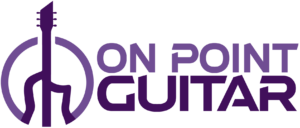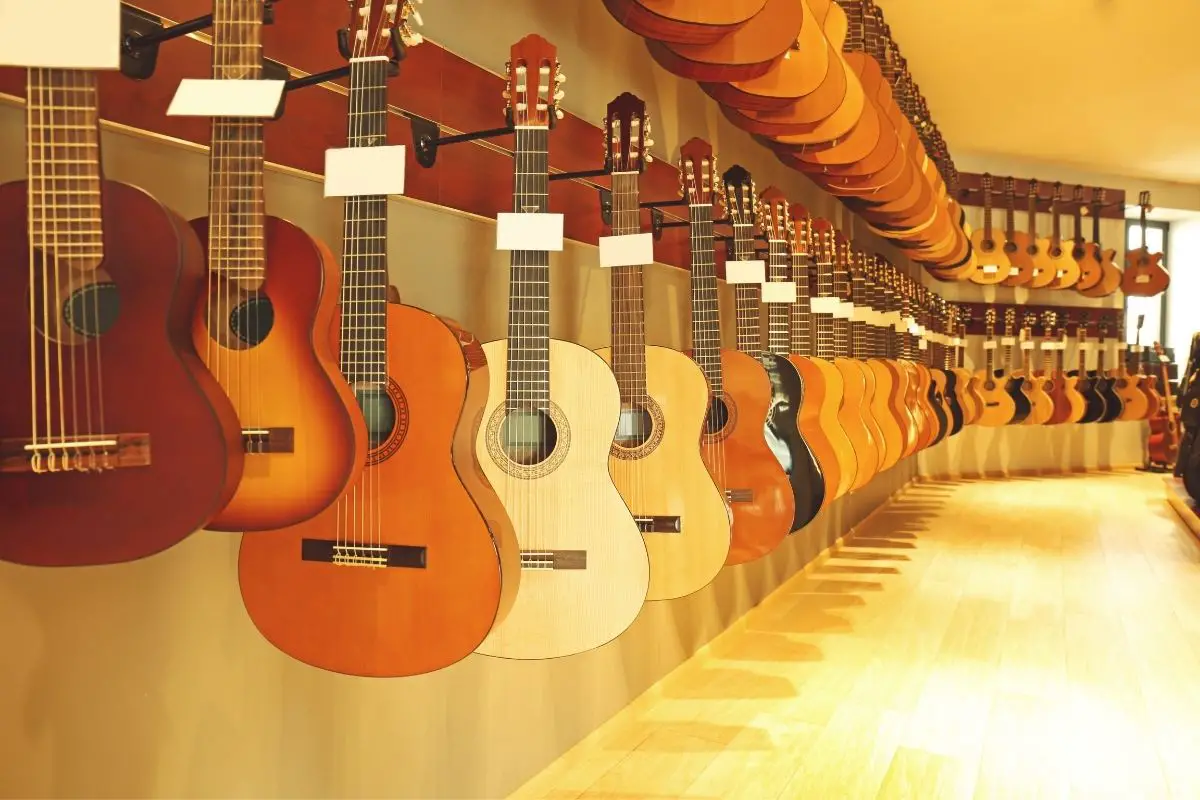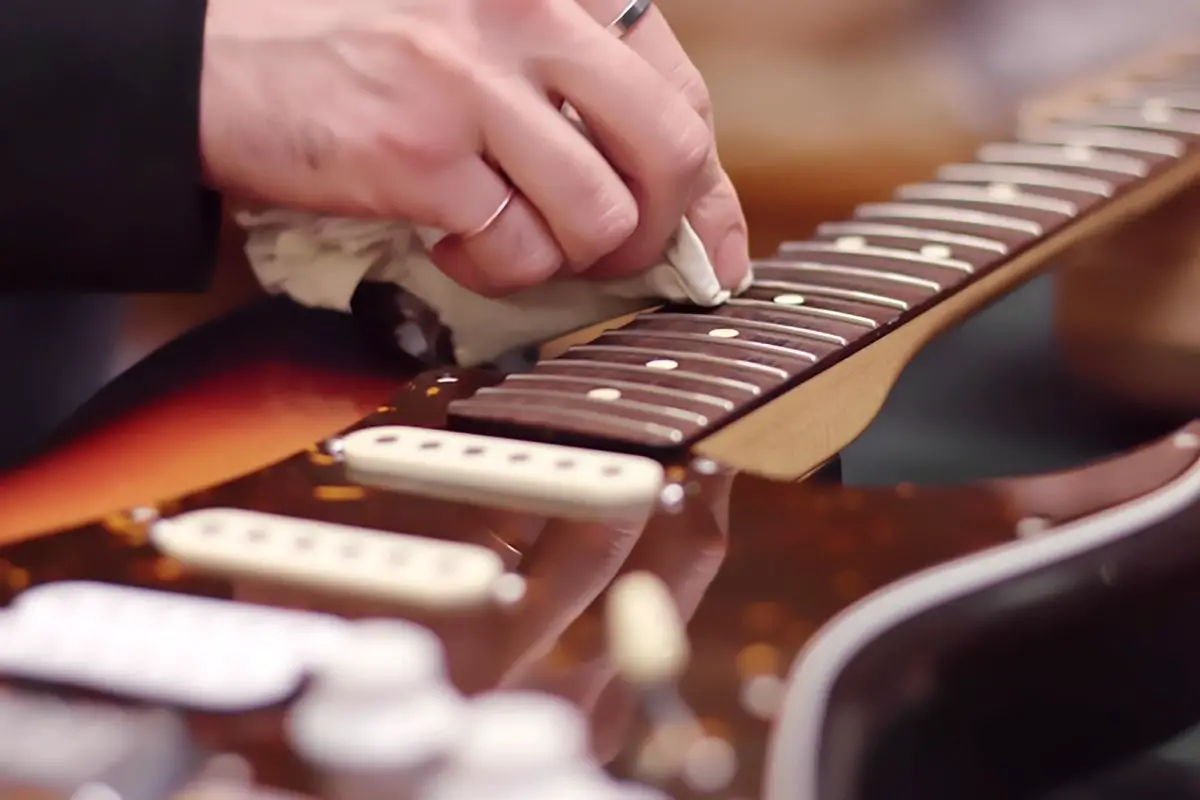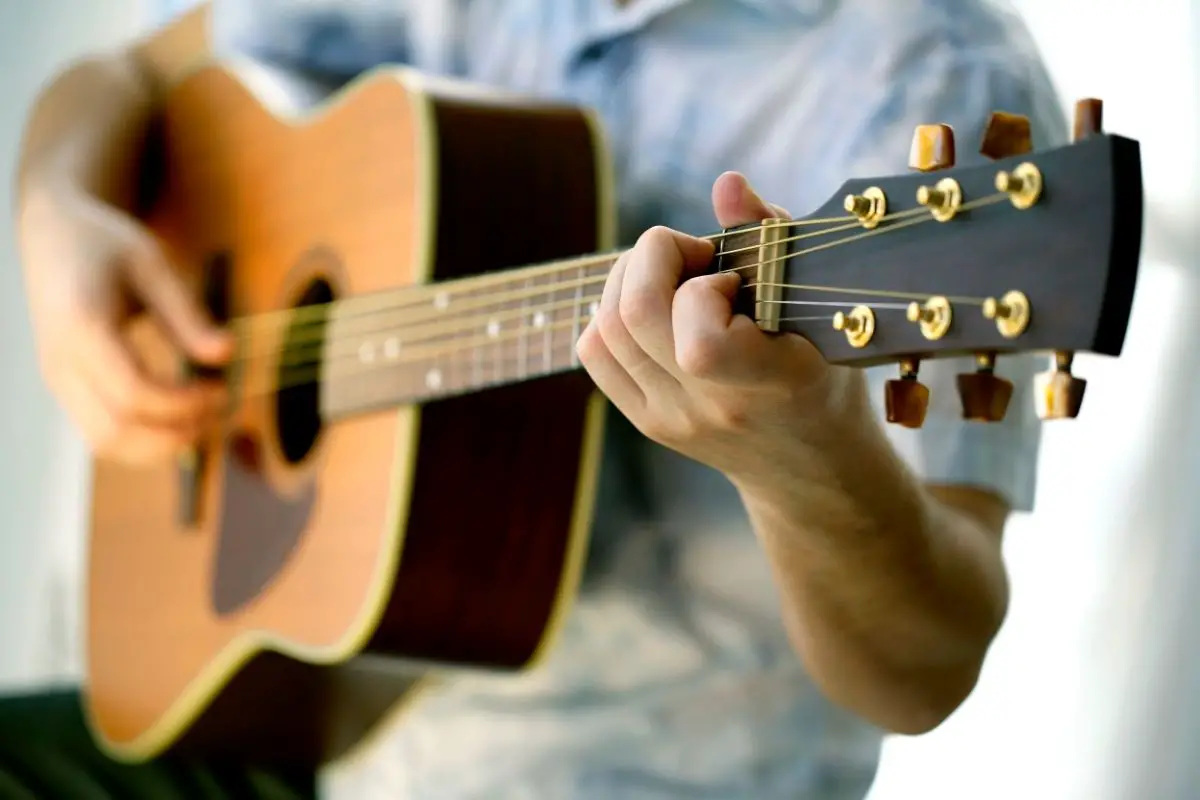Learning how to read guitar chord charts can be a daunting task for many people, and many of them are put off by the level of dedication, motivation, and patience it takes to learn.
However, while learning the guitar and how to read bass guitar chord chart can be a challenge, it doesn’t have to be a daunting one that you shy away from!

In this article, we will break down the process of learning how to read guitar chords into simple steps that anyone can follow.
We will also show you some useful tips and tricks along the way so that you can learn quickly and easily.
So, if you’re an aspiring guitarist that is eager to become the next Slash or Steve Vai, then read on for more!
Bass Guitar Chord Chart
The bass guitar is widely known for its ability to harmonise singers, guitarists, pianists, bands or orchestras; it serves other purposes. It can also be used to play chords, although bassists do not play chords as often as pianists or guitarists.
This brings us to bass guitar chord charts. Bass chords allow you to create different effects and textures with your guitar compared to the common single-note lines common with bass guitars.
Despite the fact that bassists do not play chords as often as their counterparts, it helps to know how to write or read bass guitar chord charts.
A guitar chord chart is a series of diagrams that shows you how to play a chord. For bass guitar chords, the chart will, of course, have diagrams showing you how to play certain bass chords.
There are several bass guitar chords;
- G5 – Power chord (Root, Fifth)
- G Minor – Minor chord (Root, minor 3rd, Fifth)
- G Major – Major chord (Root, major 3rd, Fifth)
- G7 – Dominant 7th chord (Root, fifth, minor 7th, Major third)
- GMaj7 – Major 7th chord (Root, Fifth, Major 7th, major 3rd)
- GMin7 – Minor 7th chord (Root, Fifth, Minor 7th, Minor 3rd)
- GSus2 – GSus2 chord (Root, major 2nd, Fifth)
- GSus4 – GSus4 chord (Root, Fourth, Fifth)
- G6 – Sixth chord (Root, Fifth, Major 6th, major 3rd)
- G9 – Ninth chord (Root, Major 3rd, Minor 7th, Major 2nd)
- GDim – Diminished chord (Root, Tritone, Octave, Minor 3rd)
- GAug – Augmented chord (Root, Major 3rd, Minor 6th)
What Is A Guitar Chord?
The guitar is arguably one of the most versatile instruments out there. There are many reasons for this, but the main reason is that it allows you to play more than one note at a time.
This is great news for aspiring guitarists because it allows them to express themselves and communicate deeper levels of meaning in song through the supporting notes.
This brings us to guitar chords. Now, anytime you choose to play more than one note at a time is technically defined as a chord, but some of the more traditional musicians, or some musicians who play classical instruments, argue that to be considered a chord, a progression must contain a minimum of three notes that have been stacked on top of one another.
They would refer to the playing of two notes at a time as a “dyad.”
Generally, a guitarist will have more freedom in their own definition of a chord. This particularly applies to guitarists that play pop music and power-chord heavy metal songs.
Whatever you choose to define as a chord or a dyad or otherwise, it is true that guitarists play on the concept of dissonance and harmony to convey or subvert a meaning or mood in music.
Typically, guitar chords all follow a basic structure in which three chords are played at a time. This is known as a triad.
The notes that you play will all be from the same scale of whichever key you are currently playing in – such as minor, major, etc.
The type of notes that you choose to play on a moment will depend on how the notes sound and work together.
So, for example, if you wanted to play a very simple chord in the major key, you can skip over every other note and only play the notes in between. This makes the C major chord, simply, C, E, and G!
However, if you’re working with a six-string guitar, then it’s likely you will be playing more than a triad. Luckily though, for a lot of songs, these will be exactly the same notes in different octaves, or even repeat notes!
This is something that makes so many people want to play, and stick to, the guitar. There are so many ways to emphasize, create, and subvert meaning through the chords that you play, as well as the ability to create full, loud sounds.
Now that we have hopefully inspired you to learn chords, the next step is to actually begin learning them. To achieve this you will first need to understand a few basics of music theory.
This is not a long process and it will make reading guitar charts much easier, so we recommend that you commit to this step – do not skip it.
Basic Music Theory To Learn Before Reading Guitar Chord Charts
At this stage, you need to start learning about a concept known as “tonal physics.” This is what a chord’s basic structure is built upon. Here are some facts that will be useful to remember!
– Chords are initially made up of how other notes react against each other when played at the same time.
– When you add more notes to a chord, it becomes a new chord. Typically, chords consist of three notes but they can consist of more, but this is part of a more complex aspect of music theory that we do not need to go into (for now.)
– Do not worry about these extra notes, because chord notations will highlight when you’re adding any extra notes that are not conventional.
How To Read Guitar Chord Charts
Now that we have established the basic aspects of music theory that you need to know, we can go ahead and move on to learning how to read guitar chord charts!
While guitar chords can seem complicated, the charts make it a whole lot easier to understand what is going on and translate it from page to stage (or playing in your bedroom, at least!)
The best thing to do as a first step is to check out a blank chord chart. These charts are made to highlight the look of a guitar fretboard head-on.
So, at the top of the chart, you will find a line (horizontal) that symbolizes the top of the fretboard. If you’re unsure what the top of the fretboard is, then it is the part of the guitar that is directly under its head.
Sometimes, certain guitar chord charts will not feature any bold line at all, and all the lines will look the same.
Do not panic if you see this, all it means is that you will not be playing any notes at the top of the fretboard, and you can find where you’re starting for this particular song by looking for the numbers located by the bass E line.
The rest of the blank chord chart will look like a grid composed of six vertical lines that are crossed with horizontal lines.
The vertical lines are representative of the guitar strings from a head-on perspective, with the line closest to the left edge of the page standing in for the low E string, and then going up from the low E string to B, G, D, A, and E.
How Can I Discern Between Notes On The Guitar Chart?
The location of the notes is usually indicated by a black dot on the guitar chord chart.
So, if you wanted to find the notes in a C major chord triad, then you would find the black dots located on the following locations:
- First fret, B string
- Second fret, D string
- Third fret, A string
These notes are normally indicated by a number, too, which tells you the finger that is best to use – some guitar chords are a lot harder to play than others!
Are Guitar Charts A Helpful Method For Aspiring Guitarists To Learn Chords?
We certainly believe so! The aforementioned chart is a great starting point for learning chords because it allows them to practice going from one point to another on the guitar – a basic step that is essential to master to be able to move on to more complex songs.
Additionally, having the numbers present can also be helpful when it comes to helping new guitarists learn to read chords. This is especially true if a chord forms a vastly different shape from the chord that preceded it.
Numbering a chart can also help make a guitarist become more intuitive. For example, if a chord is difficult to play, then players can use the chart as a guide to determine if they need to change what fingers they use in order to play the chords and make it easier for themselves.
More Essential Information For Reading Guitar Chords
There are many more notations that you will come across as you learn how to read charts. Here are a few examples!
Open Circles
If your guitar chord chart has open circles over specific strings, then this means that those strings should be left open. All this means is that this note in particular can be left alone because it fits into a chord nicely no matter what.
X’s
Contrary to the aforementioned point, if you see an “X” on specific strings on the guitar chord chart then this means that these strings will need to be dampened so that no sound is given out while you’re attempting to play.
Why Strings Need To Be Muted
Sometimes, muting a string comes down to the chord structure as it stands, but other times it comes down to the positioning of the chord on the fretboard. Muting strings when indicated can make playing that chord easier for the player, and make the sound of the guitar a lot prettier for everyone listening.
And luckily, muting a string is easy to do! You simply place your finger on it, and the sound will dampen when playing the chord – just make sure you don’t press down!
After all, you’re pressing down on a lot of strings at once here to play a chord, so it is easier for you to press down with the same intensity on all strings than it is to differ for one string and risk confusing yourself.
If you want to get in on some practice here, then you should check out chord charts that constantly change up between muted and unmuted strings, because they will help you improve the movement in your fingers and thus, your overall skill level for playing the guitar.
The Barre Symbol
The barre symbol can be found at the top of a guitar chart and looks like a parenthesis looking down – or an arc. When you see this, it is a sign to press down on every string on the fret the barre symbol is covering. When the barre symbol is placed over all six strings on a fret, then this is called a barre chord.
Barre chords are great, particularly for new guitar players! They allow a guitarist to easily transition through chord changes – so we highly recommend learning them once you have mastered the basics.
However, it is important to note that the presence of the barre symbol does not always mean that you need to play a barre chord.
This only applies when the barre symbol covers all six strings. When the barre symbol is covering a few strings, then you only need to lightly press on the strings that are covered.
The rest of the notes can be fingerpicked or played as noted. Please note that barre chords can cover strings in the middle of a chord, which is why practice is important!
Learning barre chord notations is an excellent way to learn music theory. Generally, they have the same structure across the various keys, and the only thing that changes about them is the fret that they begin on.
What Are Some Other Examples Of Guitar Chord Charts?

There are many other charts out there that are excellent in helping you learn how to read guitar chords. Different charts will be better for different people, so it’s important not to feel disheartened if one chart isn’t working out for you. Let’s look at a few examples!
Sheet Music
Traditional sheet music may be the best place for you to start, and this may be especially true if you can read sheet music for other instruments. Sheet music features notes placed on a music staff, where the note you play is indicated by the position it is in.
However, it is important to note that this is considered to be the most difficult of all the methods to learn because it doesn’t give you as much help as other guitar chord charts would.
For instance, sheet music doesn’t give you ideas for the best finger positions.
With sheet music, you have a lot more to just remember. For example, you have to remember the key you’re supposed to be in, when to change it, etc.
If you’re already knowledgeable of sheet music, you will find this a lot easier to master than someone coming into music for the first time.
Guitar Tabs
Guitar tab, or tablature, are a great way to learn how to read chords. These are the basis for guitar chord charts themselves, and they include chords in the same way that charts do.
However, a guitar tab does not always provide you with all the details you will need to learn a chord fully, so while they may be great if you’re already familiar with a chord, it will be more difficult to learn a chord that is very new to you.
Additionally, you can sometimes find tab set over sheet music. This is very useful for seeing how one translates to the other. If you want to improve your music theory, then this is a great place to start.
Musical Lead Books
Musical books are simply sheet music collections that show only the melody and basic chords for songs. The purpose of these books is for musicians to use to improve their improvisation skills.
Typically, the charts will show chord changes but will tell nothing of the specific rhythm or style of playing, so it is down to the guitarist to decide how to play the song.
More experienced guitar players can decipher the sound of a song while still being able to put their own spin on it, which means musical lead books are excellent for seasoned guitar players.
However, they are also excellent for new players. It can be a good thing to see the chords broken down into just their chords, so they can learn how to play them at a pace they’re comfortable with.
Additionally, this method allows players to learn how to play with other people, especially if playing with others puts you out of your comfort zone.
Frequently Asked Questions
There are some questions that come up a lot when learning how to read guitar chord charts. Let’s look at a few examples!
Can You Teach Yourself Guitar?
Yes! In fact, there’s no reason why you shouldn’t be able to teach yourself guitar. With the right resources, anyone can learn how to play guitar.
The biggest problem with teaching yourself guitar is that you’ll never really know what you don’t know until you’ve learned everything. That said, it’s possible to learn almost anything through practice alone.
Is Learning How To Play Guitar Hard?
Learning how to play guitar isn’t hard, but it takes dedication and patience. Most importantly, though, is finding something that you enjoy doing. Once you find that, you’ll be able to stick with it.
Guitar chord charts are an excellent way to help you learn how to play guitar because they break down the chords into easy-to-understand pieces.
They make it much easier to understand what you’re reading, and they let you focus on the parts you like best or the parts you’re struggling with.
What Should I Do If I’m Having Trouble Reading Charts?
The answer to this question depends on what kind of difficulty you’re experiencing. If you’re having trouble understanding the notes, then you’ll probably benefit from using an audiobook alongside your reading.
Audiobooks allow you to hear the notes as well as the words, making it easy to understand what’s going on.
You could even try recording yourself playing along with the chord chart and listening back to it after a few days. This will make it easier to memorize the notes.
If you’re having trouble knowing what note to play next, then you might benefit by looking at the chord progression. This is usually shown above the chord chart and shows what comes next. This will help you know what scale to move onto next.
How Long Should I Practice Before Moving On To The Next Lesson?
This depends on your goals. Some students have been playing guitar for years, and are ready to move on to the next level. They learn about how to tune a guitar to open g.
Others are just starting out, and don’t feel like they’ve mastered any particular aspect of the instrument yet. In either case, there’s no right or wrong way to approach practicing.
Practicing regularly is important, whether you’re trying to master a skill or not. Even if you aren’t sure if you’re ready to move on to something else, you should continue practicing until you reach that point.
However, if you’re feeling overwhelmed by all the information you’re getting, you may want to take a break. Try taking a day off from practicing every once in a while, and focus on something else.
Then, when you return to guitar, you won’t feel quite as stressed out about everything you need to learn.
Final Thoughts
Learning how to read bass guitar chord charts is one of the most important things you can do to improve your ability to play guitar. It’s also one of the easiest ways to get started learning how to play guitar.
However, learning to read guitar chord charts requires a lot of time, effort, and patience if you want to develop the necessary skills to become proficient. However, once you’ve done so, you’ll be able to use these techniques whenever you want.
There are many different charts you can learn from – such as traditional sheet music, musical lead books, or guitar tablature, so pick the one that suits you best and get started! You’ll be playing the most famous guitar riffs in no time at all!

My name is Howard Matthews and I have been playing the guitar since I was knee-high. My parents like to joke that I was pulling the strings even before I was born. In fact, one of my earliest memories is sitting on the couch with my dad’s guitar, wreaking havoc on the chords.
Now, 40 years later, I can attest that I play them much better than I did back then. I have followed in the footsteps of both my parents – much to their delight – and have been the main guitarist in my band for the best part of three decades.
Music has always been my passion, and until recently my life has been so consumed with it that I haven’t had a moment to have a breath (and I wouldn’t have it any other way)!








